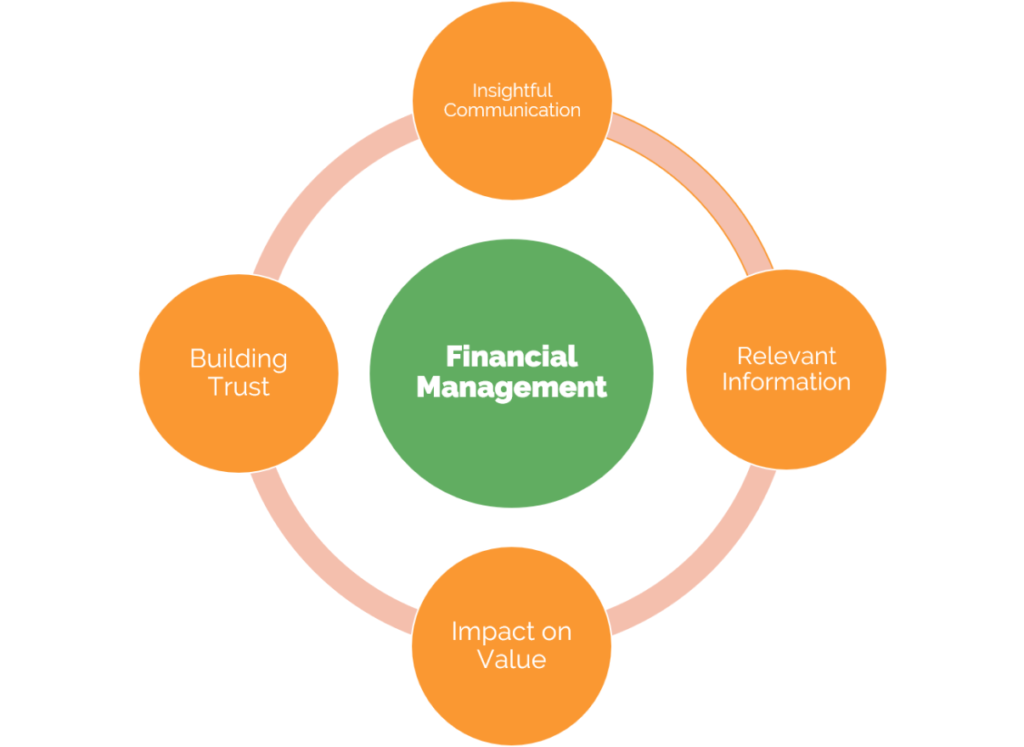In the dynamic landscape of modern business, effective financial management stands as a cornerstone of success. Managing finances isn't just about crunching numbers; it's a strategic endeavor that requires careful planning, prudent decision-making, and a clear understanding of the financial intricacies that drive a businessforward. This article delves into the various aspects of financial management for business, offering insights and strategies to navigate the complex financial terrain.
What Is Financial Management For Business?
At the core of every successful business lies the art of financial management, a dynamic discipline that encompasses a multitude of strategic activities aimed at orchestrating a company's financial resources to achieve growth, profitability, and sustainability. As aptly described by financial experts Guthman and Dougal, financial management is a multifaceted endeavor that involves planning, raising, controlling, and administering funds within a business. Let's delve deeper into the essence and implications of this critical aspect of business operations.
Holistic Financial Oversight
Financial management goes beyond mere number-crunching; it's a holistic approach to managing a company's financial ecosystem. It encompasses the entire spectrum of financial activities, from meticulously planning the allocation of resources to overseeing the actual implementation of financial strategies. This comprehensive perspective ensures that financial decisions are aligned with the company's overall objectives, fostering a seamless synergy between financial pursuits and business goals.
Strategic Planning For Financial Success
At its foundation, financial management is rooted in strategic planning. Businesses strategize not only to navigate the current financial landscape but also to chart a course toward a prosperous future. By setting financial goals, assessing market dynamics, and analyzing growth opportunities, financial managers position their organizations to capitalize on emerging trends while weathering potential challenges.
Raising Capital For Growth
One of the pivotal roles of financial managementis raising capital. Businesses require funds to operate, expand, and innovate. Financial managers are tasked with identifying optimal sources of capital, whether through equity financing, debt issuance, or other means. They evaluate the risk-return trade-offs associated with different funding options to make informed decisions that align with the company's financial objectives.
Control And Prudent Resource Allocation
Control is a cornerstone of financial management. Effective financial control entails overseeing financial transactions, monitoring cash flows, and ensuring adherence to budgets. Financial managers implement internal controls to prevent fraud, manage risks, and maintain the integrity of financial data. Prudent resource allocation involves directing funds to areas that promise the highest return on investment, thereby maximizing the efficient use of available resources.
Administering Funds Wisely
The administration of funds involves making tactical decisions to optimize financial performance. This includes managing short-term working capital needs, determining appropriate inventory levels, and orchestrating cash flow cycles to ensure liquidity. By skillfully administering funds, financial managers enable companies to fulfill their obligations while seizing growth opportunities without compromising financial stability.
Profitability And Scalability
Ultimately, the goal of financial management is to foster profitability and scalability. Financial decisions are not isolated actions; they have a cascading effect on a company's bottom line and long-term viability. Through effective financial management, businesses can enhance their profitability by generating revenue, controlling costs, and making strategic investments that yield substantial returns. Moreover, scalable financial strategies are designed to accommodate growth without causing undue strain on resources.
Adaptation And Flexibility
Financial management operates in a dynamic environment characterized by evolving market trends, regulatory changes, and technological advancements. A successful financial manager is not only proficient in current financial practices but also adaptable and forward-thinking. Being attuned to industry shifts and embracing innovative financial technologies ensures that the company remains resilient and competitive in an ever-changing landscape.
Ethical And Transparent Practices
Ethics and transparency are intrinsic to effective financial management. Adhering to ethical standards and transparent reporting practices not only instills trust among stakeholders but also mitigates reputational and legal risks. Financial managers are stewards of their company's financial integrity, ensuring that financial data is accurately represented and that financial decisions are made in the best interest of the company and its stakeholders.
Objectives Of Financial Management
Financial management plays a pivotal role in steering a business towards success. It revolves around the procurement, allocation, and control of financial resources, driving the achievement of various strategic objectives. Let's delve deeper into the key objectives that guide the financial management process:
Ensuring Regular And Adequate Supply Of Funds
One of the fundamental objectives of financial management is to ensure that a business has a consistent and sufficient influx of funds. This is crucial for maintaining day-to-day operations, investing in growth opportunities, and fulfilling financial obligations. Adequate funds provide the necessary liquidity to navigate uncertainties and seize strategic initiatives without disruptions.
Securing Adequate Returns To Shareholders
Shareholders are the stakeholders who invest in a company with the expectation of generating returns on their investment. Financial management aims to uphold the interests of shareholders by ensuring that the company's financial decisions lead to satisfactory returns. Factors influencing these returns include the company's earning capacity, prevailing market price of shares, and shareholders' expectations.
Optimizing Funds Utilization
Once funds are procured, their efficient utilization becomes paramount. Financial management strives to maximize the utilization of available resources while minimizing costs. Efficient funds utilization can result in higher profitability, improved operational efficiency, and the ability to capitalize on growth prospects.
Ensuring Safety Of Investments
Investments play a critical role in a company's financial landscape. Financial management is responsible for directing funds into ventures that offer a reasonable balance between risk and reward. By investing in safe and viable projects, a company can achieve a consistent rate of return while minimizing exposure to undue risks that could jeopardize financial stability.
Planning A Sound Capital Structure
The capital structure of a company refers to the composition of its financing sources, including debt and equity. An important objective of financial management is to strike a balance between these two components. Maintaining a sound capital structure ensures the company has the optimal mix of financing that aligns with its risk tolerance, growth aspirations, and overall financial health.
Enhancing Long-Term Financial Viability
Financial management goes beyond short-term objectives and aims to bolster a company's long-term financial viability. This involves strategic planning and decision-making that pave the way for sustained profitability, growth, and resilience. By making well-informed financial choices, a company can withstand market fluctuations, economic downturns, and competitive challenges.
Facilitating Strategic Decision-Making
Effective financial management provides crucial insights that guide strategic decision-making across the organization. By analyzing financial data and performance metrics, decision-makers can make informed choices about resource allocation, expansion initiatives, product development, and more. These decisions contribute to the company's overall growth trajectory and competitive advantage.
Ensuring Compliance And Transparency
Financial management is closely tied to adhering to legal and ethical standards. This objective involves maintaining accurate and transparent financial records, following Generally Accepted Accounting Principles (GAAP), and meeting regulatory requirements. Compliance not only ensures the company's credibility but also mitigates legal risks and potential financial penalties.
Minimizing Financial Risks
Risk is an inherent aspect of any business venture. Financial management aims to identify, assess, and mitigate various financial risks that could impact the company's stability and growth prospects. By implementing risk management strategies, such as hedging against currency fluctuations or diversifying investments, the company can safeguard its financial well-being.
Supporting Growth And Innovation
Financial management plays a pivotal role in nurturing growth and driving innovation within a company. Adequate funding, prudent investment decisions, and strategic resource allocation enable the company to explore new markets, develop innovative products, and pursue expansion opportunities that contribute to long-term success.
In essence, the objectives of financial management encompass a spectrum of strategic goals that collectively contribute to a company's financial health, sustainability, and growth. By aligning financial decisions with these objectives, businesses can navigate the complex financial landscape with confidence and forge a path to lasting success.
Managing Cash Flow - Navigating The Financial Currents
Maintaining a robust cash flow is not just a financial nicety; it's a fundamental requirement for sustaining daily operations and propelling a business towards growth. Effective cash flow management entails the careful orchestration of cash inflows and outflows to ensure that a business has the necessary liquidity to meet its financial commitments and seize strategic opportunities. Let's delve deeper into the intricacies of managing cash flow, a cornerstone of financial success.
Cash Flow Forecasting
Cash flow forecasting is akin to plotting a financial roadmap for a business. It involves predicting the movement of cash into and out of the company over specific time frames. This foresight enables proactive decision-making and helps prevent cash shortages or surpluses that could disrupt operations.
Short-Term Forecasting
Short-term cash flow forecasting provides insight into immediate financial requirements. By estimating cash inflows from sales, investments, and other sources, and balancing them against anticipated cash outflows for expenses, salaries, and taxes, businesses can ensure they have the liquidity to cover their short-term obligations.
Long-Term Forecasting
Long-term cash flow forecasting focuses on the strategic horizon. Businesses use this approach to plan for major investments, expansions, or the repayment of long-term debts. By considering potential shifts in the economic landscape and industry trends, companies can make informed decisions about their financial commitments and growth trajectories.
Working Capital Management
Working capital is the lifeblood that keeps a business running smoothly. It represents the funds available for daily operations and growth initiatives. Effective working capital management involves optimizing key components to strike a balance between maintaining liquidity and utilizing resources efficiently.
Inventory Control
Inventory levels directly impact working capital. Maintaining excessive inventory ties up valuable funds, while inadequate inventory can lead to stockouts and lost sales. By implementing inventory control measures, businesses can ensure optimal stock levels that align with demand and prevent unnecessary capital immobilization.
Accounts Receivable And Payable
Balancing the timing of payments from customers to suppliers is critical for maintaining a healthy cash flow. Extending credit terms to customers should be carefully managed to minimize the risk of late payments, while negotiating favorable terms with suppliers can provide the company with more flexibility in meeting its financial obligations.
Capital Structure And Financing
The capital structure of a business influences its financial stability, risk profile, and capacity to fund growth initiatives. Deciding between debt and equity financing requires a thoughtful assessment of the company's financial needs and risk tolerance.
Debt Vs. Equity Financing
Debt Financing:This involves borrowing funds with the obligation to repay the principal amount along with interest over a specified period. While debt financing can provide immediate capital, it also comes with the burden of interest payments and potential repayment obligations. Careful consideration is necessary to avoid overleveraging the business and endangering its financial health.
Equity Financing:Equity financing involves selling ownership stakes in the company in exchange for capital. This approach doesn't create repayment obligations, but it does dilute ownership. Businesses must weigh the benefits of raising capital without incurring debt against the loss of ownership control.
Cost Of Capital
The cost of capital, often measured by the Weighted Average Cost of Capital (WACC), is a critical consideration in financial decision-making. It reflects the average cost of both debt and equity financing and serves as a benchmark for evaluating the feasibility of potential investments. Projects with expected returns above the WACC are generally considered viable, as they generate value in excess of the cost of capital.
Risk Management And Contingency Planning - Safeguarding Financial Stability
In the ever-evolving landscape of business, risk is a constant companion. Effective risk management is akin to a strategic shield that shields a company from potential vulnerabilities while maximizing its potential for growth. This multifaceted process involves identifying potential threats, devising strategies to mitigate their impact, and preparing for unforeseen contingencies. Let's delve deeper into the intricacies of risk management and the importance of contingency planning.
Identifying Risks
Successful risk management commences with a comprehensive assessment of potential risks that could impact a company's financial health and operational continuity. These risks can be broadly categorized into:
Market Risks
Market dynamics are subject to fluctuations in demand, competition, and broader economic conditions. Identifying and understanding these shifts can help businesses adjust their strategies to remain competitive and responsive to changing consumer needs.
Operational Risks
Internal processes, technology failures, and supply chain disruptions can significantly disrupt a company's operations. It's crucial to anticipate these risks and put measures in place to minimize their impact and maintain operational efficiency.
Financial Risks
Financial markets are subject to volatility, and businesses can be exposed to risks such as currency fluctuations, changes in interest rates, and credit risks. Effective financial risk management involves strategies to hedge against these uncertainties and safeguard financial stability.
Contingency Plans
Contingency planning is a preemptive strategy that involves developing well-thought-out responses to potential risks. It's about having a proactive approach to crises rather than merely reacting when they occur.
Emergency Fund
Maintaining an emergency fund is akin to having a financial safety net. This reserve is set aside to cover unexpected expenses or revenue shortfalls during challenging times. Having a readily accessible pool of funds provides businesses with the liquidity needed to weather storms and continue operations without disruption.
Insurance Coverage
Insurance serves as a shield against specific risks that could have significant financial repercussions. Different types of insurance, such as property damage, liability, or business interruption coverage, provide businesses with a layer of protection against potential losses that could arise from unforeseen events.
Continuous Monitoring And Adaptation
Financial management is not a one-time endeavor; it's an ongoing process that requires vigilance and adaptability. Regular monitoring, analysis, and adaptation are essential to ensure that a business remains aligned with its financial objectives and responsive to market dynamics.
Key Performance Indicators (KPIs)
KPIs serve as the compass by which a business navigates its financial journey. Monitoring metrics like revenue growth and profit margins provides insights into the effectiveness of financial strategies. It helps companies gauge their financial health, identify trends, and make informed decisions.
Flexibility In Strategy
The business landscape is marked by uncertainty, and financial strategies must be flexible enough to adapt to changing conditions. Scenario planning involves anticipating various economic scenarios and developing strategies that can be deployed should those scenarios come to pass. Additionally, regular review and adjustment of budgets ensure that financial plans remain relevant and effective in dynamic environments.
Seeking Professional Guidance
Given the complexities of financial management, seeking professional guidance is a prudent move. Financial experts, including accountants, financial advisors, and Chief Financial Officers(CFOs), bring specialized knowledge and experience to the table. Their insights help businesses make informed decisions, optimize financial strategies, and navigate challenges with confidence.
Financial Analysis And Reporting
Amidst the dynamic currents of the business world, financial analysis and reporting stand as the lighthouse, guiding companies through the fog of uncertainty. This crucial aspect of financial management goes beyond numbers—it entails deciphering financial data to extract insights that fuel strategic decision-making. Coupled with transparent and accurate financial reporting, this process not only empowers internal stakeholders but also communicates a company's financial health to external partners. Let's delve deeper into the significance and nuances of financial analysis and reporting.
Financial Ratios - Navigating Financial Performance
Financial ratios are akin to a financial toolkit that provides a comprehensive view of a company's performance. These ratios offer insights into various aspects of financial health, allowing businesses to benchmark themselves against industry standards and historical data.
Liquidity Ratios
Liquidity ratios assess a company's ability to meet short-term obligations. The current ratio, for instance, measures the company's ability to pay its short-term liabilities using its short-term assets. The quick ratio, another liquidity metric, takes into account only the most liquid assets (excluding inventory) in relation to short-term liabilities. These ratios ensure that a company has the necessary liquidity to navigate immediate financial demands.
Profitability Ratios
Profitability ratios delve into a company's ability to generate profits relative to different metrics. Return on assets (ROA) measures how efficiently a company uses its assets to generate profits, while return on equity (ROE) focuses on the return earned on shareholders' equity investment. These ratios shed light on a company's ability to convert resources into profit and provide insights into its operational efficiency and overall financial performance.
Transparency And Compliance - Building Trust In Reporting
For more insights into financial management and success strategies, you can also explore this article.
Transparency and compliance are not just buzzwords; they are foundational pillars of credible financial reporting. By adhering to Generally Accepted Accounting Principles (GAAP), businesses ensure consistent and transparent financial reporting practices. This not only fosters trust among stakeholders but also facilitates meaningful comparisons between different companies and industries.
GAAP Standards
GAAP standards provide a standardized framework for financial reporting. By adhering to these principles, companies ensure that their financial statements accurately represent their financial position, performance, and cash flows. This consistency allows investors, analysts, and regulators to make informed decisions based on reliable information.
Regulatory Compliance
Beyond GAAP, businesses must also meet specific legal requirements and industry regulations. Regulatory compliance helps maintain credibility and trust in financial reporting. Avoiding penalties and legal repercussions hinges on accurate and timely reporting that meets the expectations of regulatory bodies.
People Also Ask
What Is The Financial Management Of A Business?
Financial management of a business refers to the strategic process of planning, organizing, controlling, and directing the financial resources of a company in order to achieve its financial goals and objectives. It involves making informed decisions about how toacquire, allocate, and utilize funds effectively to ensure the financial health and success of the organization. Financial management encompasses a wide range of activities, including budgeting, forecasting, cash flow management, risk assessment, investment analysis, and financial reporting.
What Are The 5 Basic Of Financial Management?
The five basics of financial management are:
- Financial Planning:Setting clear financial goals and outlining strategies to achieve them. This involves creating budgets, identifying funding sources, and planning for short-term and long-term financial needs.
- Budgeting:Developing a structured plan that allocates financial resources to various activities and departments within the organization. Budgeting helps control spending, track expenses, and ensure that funds are used efficiently.
- Cash Flow Management:Managing the inflow and outflow of cash to ensure the availability of funds for day-to-day operations, investments, and financial obligations. Effective cash flow management prevents cash shortages and optimizes liquidity.
- Risk Management:Identifying potential financial risks that could impact the organization and developing strategies to mitigate their effects. This involves assessing market risks, operational risks, and financial risks, and implementing contingency plans.
- Financial Reporting and Analysis:Generating accurate and transparent financial reports that provide insights into the company's financial performance. Financial analysis involves interpreting these reports to make informed decisions, evaluate profitability, assess financial health, and plan for the future.
What Are The 4 Processes Of Financial Management?
The four processes of financial management are:
- Financial Planning:This process involves setting financial goals, creating budgets, and formulating strategies to achieve those goals. It encompasses both short-term and long-term financial planning.
- Acquisition of Funds:This process involves sourcing funds from various channels, such as equity financing, debt financing, retained earnings, or external investors. The goal is to ensure that the company has the necessary capital to fund its operations and growth initiatives.
- Resource Allocation:After acquiring funds, financial managers allocate resources to different departments, projects, and activities based on their importance and potential return on investment. This process ensures efficient utilization of available funds.
- Financial Control and Monitoring:Once funds are allocated, financial managers continuously monitor and control the financial activities of the organization. This involves tracking actual financial performance against the budget, implementing internal controls, managing cash flow, and addressing any deviations from the plan.
Conclusion
In the intricate world of business, mastering financial management is the compass that guides organizations toward sustainable success. From the art of budgeting to the science of risk management, each facet of financial management contributes to a company's stability, growth, and resilience.
By strategically allocating resources, navigating cash flows, and fostering ethical financial practices, businesses can weather uncertainties, seize opportunities, and shape a future defined by financial prosperity. Through vigilance, adaptability, and the guidance of experts, financial management becomes not just a necessity, but a strategic cornerstone that transforms challenges into stepping stones toward enduring achievement.



